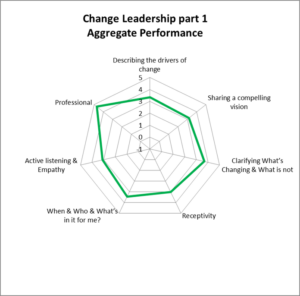Leadership Behaviours, Soft Skills
“I wish I knew… how to identify blind spots that my managers have when leading change
At the Experience Accelerator, we have been working hard to deliver better performance in the area of behavioural skills.
In this third of our three part series, we showcase one way of how we can answer “I wish I knew… how to identify blind spots that my managers have when leading change”.
The path of transformation is littered with costly failures and, increasingly in the literature, the root cause of these failures are linked to lack of alignment, missing bottoms up engagement (eg. what’s in it for me?), weak senior leadership behavioural role modelling and insufficient explanation as to the “WHY?” of change.
So much has been written about these root causes of change failure and yet we find relatively few companies who routinely evaluate how well their leaders and managers are a) sharing a compelling vision, b) practicing and iterating their strategic narratives, c) engaging their teams by translating the big change vision into tangible benefits for their departments and so on.
We were lucky enough to work with one of these forward thinking companies in the pharmaceutical industry. Rather than leave these important leadership behaviours to chance, they invited us in to diagnose change leadership strengths and development areas for a group of General Managers and then craft a learning journey to close some of the gaps we observed.
In our initial practice-based assessment, our GMs were able to:
1. Clarify what is changing and what is not
2. When, Who & What’s in it for me?
3. Demonstrate a high level of professionalism in their virtual meetings
Almost uniformly, there were improvements to be made in the areas of
1. Sharing a compelling vision
2. Receptivity to opposing or contrarian views
3. Active Listening & Empathy

Whilst our GMs were able to articulate well the values that would govern the change process, they omitted to convey a vision which contained details of the destination, eg. What will good look like when we are done? And also the purpose, eg. What greater good will we have when we are done? What’s meaningful about why we are making the change?
The behaviours of empathy, active listening and receptivity are all closely intertwined. We observed a natural tension between the information the leader wanted to share and the reaction of the employee receiving it. This requires dedicated active listening, empathetic behaviour and a willingness to ask open questions that as a leader one may not know the answers to. Additionally, a number of colleagues struggled with the concept of being open to diverse perspectives – it was as if they felt disloyal to the hierarchy and/or the change initiative itself if they allowed dissension in the ranks!
The type of behavioural impact our learners reported included:
- I’m so much better at starting with the “why?”
- I’m asking more open questions
- I’m better at understanding emotions and reactions of employees involved in change
- Triggers: it really helps to think about an individual’s journey through change
- Asking questions, giving the team the opportunity to express their feelings and ideas makes it easier to cooperate.
- I think harder about my communications plan during times of change
Which has led to these positive outcomes:
Team is more aligned and engagement has improved, particularly after I started to share my vision.
Team/Individual has more mental ownership of their role within the change
We have better predictability of process change outcomes
The trust level increased in the team and we operate as a “unit” altogether
The conflicts and misunderstandings we had are now dealt with much faster and are resolved
For less than 2 hours virtual learning invested per learner, the learner gets a personalised tailored feedback report on what they did well and where they can improve, the L&D team now has a treasure trove of aggregated data on priorities for their change leadership efforts and the leadership team gets to see how their change leadership culture shows up in real life. This ain’t your grandma’s virtual learning!
If this work is interesting to you, check out the previous two blogs in this series
I wish I knew…how to prioritise the topics which matter most for soft skills performance
I wish I knew…what soft skills my managers need to improve
or sign up for a 15 minute virtual coffee today

